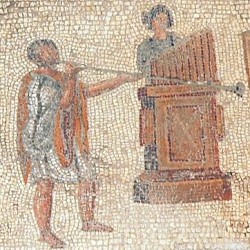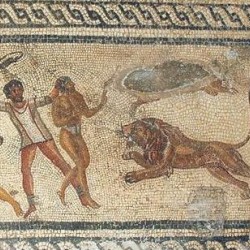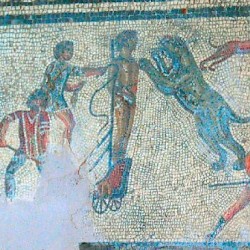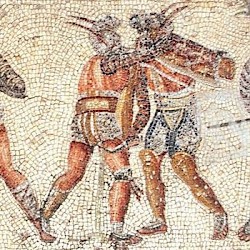Lepcis Magna, Amphitheater
Q2844413Lepcis Magna: Phoenician colony, later part of the Carthaginian empire, the kingdom of Massinissa, and the Roman empire. Its most famous son was the emperor Septimius Severus (r.193-211).
Amphitheater

The Amphitheater of Lepcis Magna was excavated in a natural depression, or a former quarry, in the rocky terrace to the southeast of the city, close to the sea. Behind it, even closer to the sea, was the circus, which is about a century younger. About 16,000 people could be accommodated in the stands of the amphitheater, which was about a kilometer from the city.
An inscriptionnote informs us that the amphitheater was inaugurated by governor Marcus Pompeius Silvanus Staberius Flavinus of Africa, in his third year in office, and that Quintus Cassius Gratus was his deputy. They dedicated the monument to the young emperor Nero (r.54-68). This means that the monument was finished in 56.

The oval arena measures 57 x 47 m. The lower ranks were for the Lepcitanian elite, and from inscriptions we can deduce that they preferred the southeastern side of the amphitheater, where they would enjoy the smooth wind.Today, you can still see the stone slabs that were once on the seats and other pieces of natural stone. Among these is an altar for Nemesis, the goddess of doom, and a favorite deity in Roman amphitheaters.
Not far from Lepcis is the Villa Dar Buc Ammera, which contained a large mosaic dedicated to the fights in the arena of Lepcis Magna. A normal show started early in the morning, when animals had to fight against each other, like a bull and a bear. The usual item at noon was the execution of criminals who were thrown ad bestias.
One scene in the Villa Dar Buc Ammera shows the execution of a criminal. He has been tied to a pole and is brought into the arena, where a hungry panther will kill him. The man has a dark skin and may have been one of the native Garamantes. In the Year of the Four Emperors (69 CE), the inhabitants of Oea had seized the opportunity offered by the civil war to attack the people of Lepcis Magna, and the Garamantes had joined them. Order was restored by general Valerius Festus in 70, and it is possible that the enemies were executed in this fashion.
The gladiators performed in the afternoon. The ones on the mosaic can be identified as a murmillo (left: one greave, helmet's crest) and a thraex (right: high greaves). The fighter to the left appears to have advanced his right leg too far before his left, and has taken a backhanded draw-cut to the back of the thigh as a result. Blood is falling down and he will soon die a painful death, unless he receives a coup de grâce.
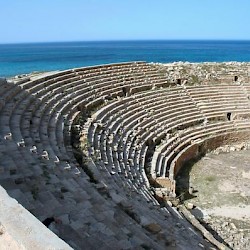 Lepcis, Amphitheater, seats |
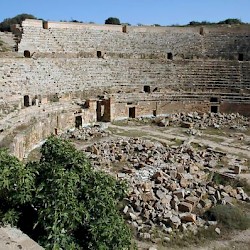 Lepcis, Amphitheater, arena |
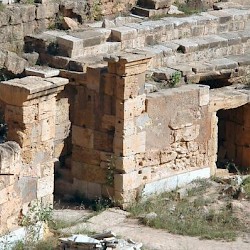 Lepcis, Amphitheater, entrance |
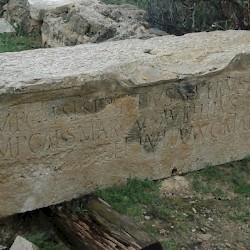 Lepcis, Amphitheater, inscription of Septimius Severus, Caracalla and (erased) Geta |

It is likely that there was some sort of (wooden) portico surrounding the amphitheater: these were the cheaper seats. An access to the southeast, once lead to a sanctuary, dedicated to the goddess Artemis (or Diana), as she was venerated in Ephesus.
Below, you can see the cult statue, made during the reign of Hadrian (r.117-138), excavated in 1912, and today on display in the National Archaeological Museum in Tripoli. The cult of this "great mother goddess" was extremely popular in the ancient Mediterranean world, and it comes as no surprise to find a sanctuary in a great cosmopolitan city like Lepcis Magna.
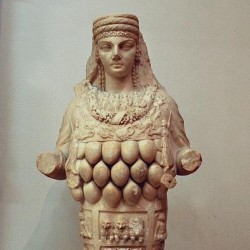 Lepcis Magna, Amphitheater, Artemis of Ephesus |
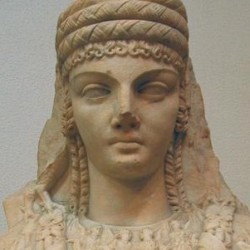 Lepcis Magna, Amphitheater, Artemis of Ephesus |
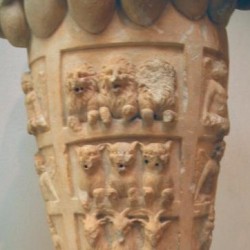 Lepcis Magna, Amphitheater, Artemis of Ephesus |
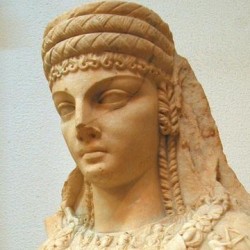 Lepcis Magna, Amphitheater, Artemis of Ephesus |
